In manga, line effects, or kouka-sen 効果線, literally "effect lines," are lines drawn in the background or the foreground of manga panels, and in anime, that represent some sort of effect, like the emotion of objects or the mood of characters and places.
Background Types
For reference, a summary of types of line effects and their respective functions.
動線
The "motion lines," dousen 動線, to depict movement and the trajectory of objects.
In some cases they end up conveying more information than just movement, like when a character shakes their head.
- Context: Kenshirou ケンシロウ asks a girl how is life.
- .........tsurai ka......
・・・・・・・・・つらいか・・・・・・
Is it tough? - *shakes head*
- kubi wo yoko ni furu
首を横に振る
To shake [one's] head horizontally. (a gesture that means "no.") - kubi
首
Neck. (can also mean head in some cases.)
- kubi wo yoko ni furu
スピード線
The "speed lines," supiido-sen スピード線, are lines that convey a sense of speed.
- hayai!
速い!
[He] is fast!
This same sort of line can also convey emotion and fervor, usually when they're drawn coming from the bottom.
- Context: you can hear the screaming in these vertical lines.
- kimi wa hiiro ni nareru
君はヒーローになれる
You can become a hero.
揺れ線
The "wavering lines," yure-sen 揺れ線, are lines drawn surrounding objects that depict unstable movement, or slight movement. They're drawn in various ways depending on the sort of movement.
- Soft things that turn around are surrounded by curves.
- Stiff, metal things that don't bend are surrounded by straight lines.
In general, motion lines are only depicted in manga, not in anime, since you can just animate the motion in anime.
However, shaking lines are drawn even in anime when they represent emotions, like shaking with fear or excitement.
- Context: Agatsuma Zenitsu 我妻善逸 trembles with fear.
Air, Smell and Heat
Sometimes, wavy lines are used to indicate the motion of air, mainly when a smell is coming from an object, or when hot air is coming from an object.
Right: Medusa, メデューサ
Anime: Jashin-chan Dropkick', 邪神ちゃんドロップキック’ (Season 2) (Episode 6)
- Context: Medusa cries from the smell of onions coming from the bowl she's holding, which is symbolized by blue wavy lines.
Anime: Kobayashi-san Chi no Maidragon S, 小林さんちのメイドラゴンS (Season 2) (Episode 10)
- Context: Kanna spilled tea on her homework, now she's trying to dry it using a hairdryer. Yellow wavy lines symbolize the hot air coming from it.
集中線
The "focus lines," shuuchuu-sen 集中線, are drawn from the edges of a panel toward the center, or toward an element of focus.
There are various reasons for them to be drawn, including when an object is indeed the focus of the panel:
- Context: Midoriya Izuku 緑谷出久 realizes something about himself.
- kono taiyaki ga boku'...desu!!
このたい焼きが僕っ・・・です!!
This taiyaki... is me!!- taiyaki たい焼き
A sort of fish-shaped pancake.
- taiyaki たい焼き
And when a character is concentrated and uses a skill:
- Context: a ninja activates their special eyes.
- byakugan!!
百眼!!
White eyes!!
おどろ線
The odoro-sen おどろ線, literally "odoro lines," are lines similar to the focus lines, but a bit more ominous, drawn when something is odoro-odoro-shii おどろおどろしい, "eerie," when a character feels uneasy, or when they feel angry.
放射線
The word housha-sen 放射線 mean "radiation rays," probably the deadly kind, but, in manga, when lines are drawn "radiating" from a character, that means the character is cheerful, is happy.
- Context: Nami ナミ cheers up.
- honto!?
ほんと!?
Really!?- hontou 本当 with the long vowel shortened.
Ropes
In manga, when a kakeami カケアミ hatching pattern is used to draw ropes in the background of a panel, those ropes are called nawaami ナワアミ, and they generally mean the character is worried or anxious.
- ...okuyami wo tsutaete kudasai
・・・おくやみをつたえてください
...communicate my condolences. - makoto ni zan'nen desu to
まことに残念ですと・・・・・・・・・・・・
[Say] that [it was] truly unfortunate............
[Say] that [I'm terribly sorry for what happened]............
タレ線
The "dripping lines," tare-sen タレ線, are vertical lines drawn dripping from the top of the panel, used when a character feels down, depressed, or shocked, among other uses.
- zuun
ずーん
(sound effect used when a character suddenly feels down.)
Mark Types
Typically, the term kouka-sen 効果線 applies only to lines that cover objects and or fill the background. Besides such lines, there are also some marks which are drawn using only lines which I'll include here for reference.
照れ線
A bunch of diagonal lines, ///, called tere-sen 照れ線, "embarrassed lines," or sha-sen 斜線, "oblique lines," are used render a blush when a character's face turns red.
Anime: Excel♥Saga, エクセル♥サーガ (Episode 4)
Blue Lines
In anime, blue lines are used in numerous ways and forms. The tare-sen are generally blue when drawn in color, but besides them, some lines drawn horizontally are also rendered blue and have similar meanings.
Right: Suou Tamaki 須王環
Anime: Ouran High School Host Club, Ouran Koukou Hosuto-Bu 桜蘭高校ホスト部 (Episode 1)
ニコ線
The "smile lines," nico-sen ニコ線, are drawn over a character when they're laughing or having fun.
Realization Mark
A realization mark is sometimes drawn as a few lines next to a character's head. These are used when they notice or realize something.
し
A line curved like the shi し hiragana, that is, like a hook, is typically a quick way to draw a small sweat drop.
Right: Masaki Tenchi 柾木天地
Anime: Tenchi Muyou! Ryououki 天地無用!魎皇鬼 (OVA, Episode 1)
怒りマーク
The "anger mark," ikari maaku 怒りマーク, is a symbol representing a popped vein typically drawn using three or four curved lines.
Anime: Hataage! Kemono Michi 旗揚!!けものみち (Episode 4)
References
- 効果線 - ja.wikipedia.org, accessed 2020-02-27.
- 効果背景解説・効果背景集-1 - nancga.ninja-web.net, accessed 2020-02-31.
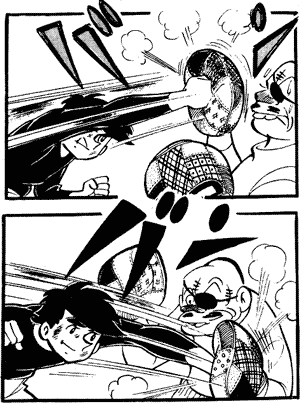
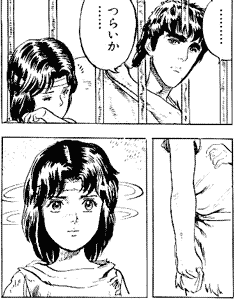

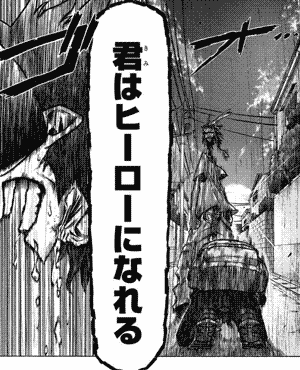
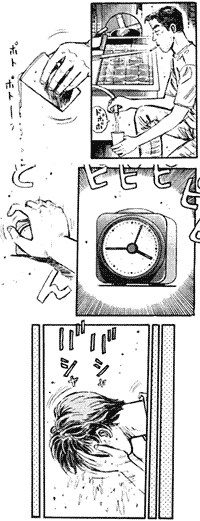
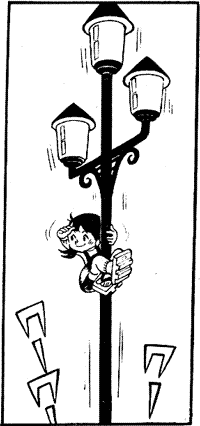

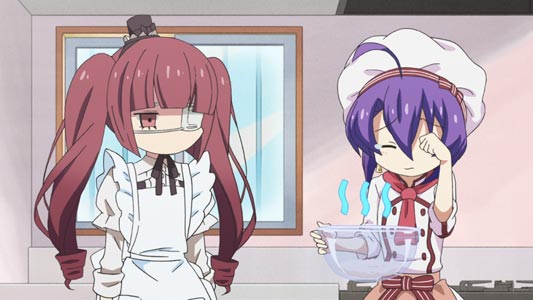
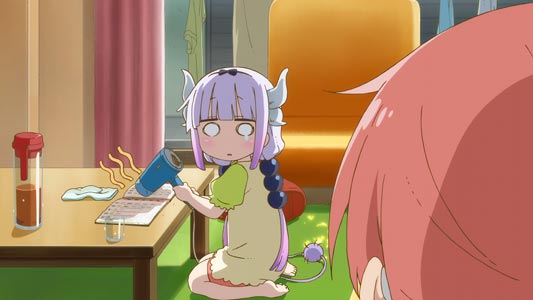
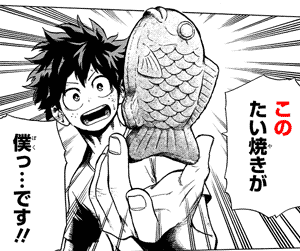
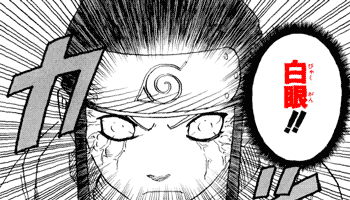
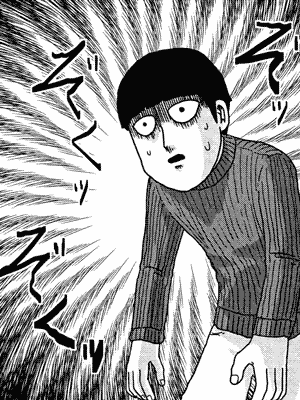
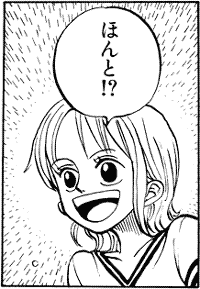
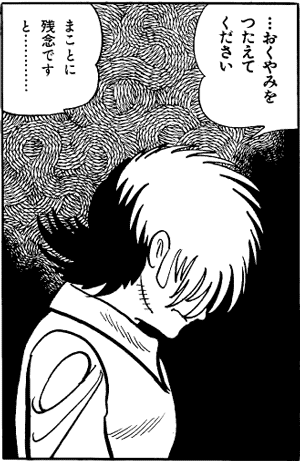
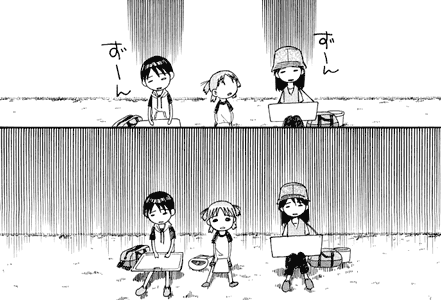
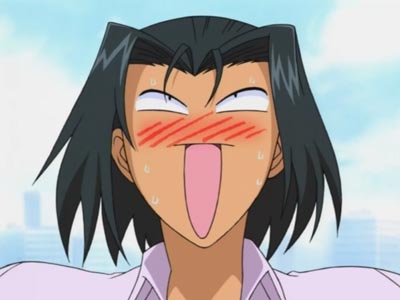
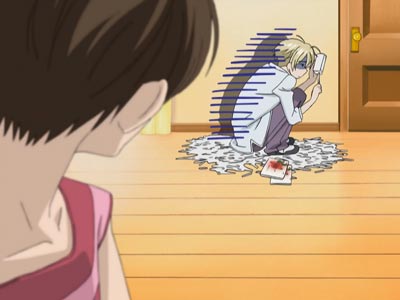
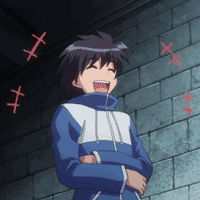
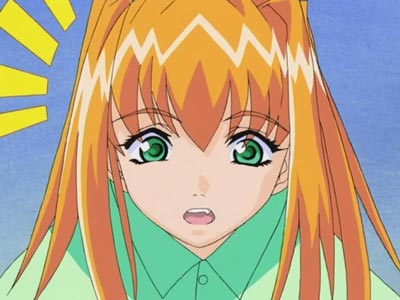
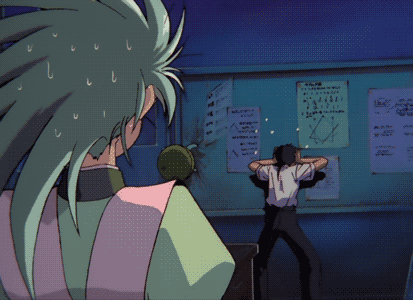

No comments: